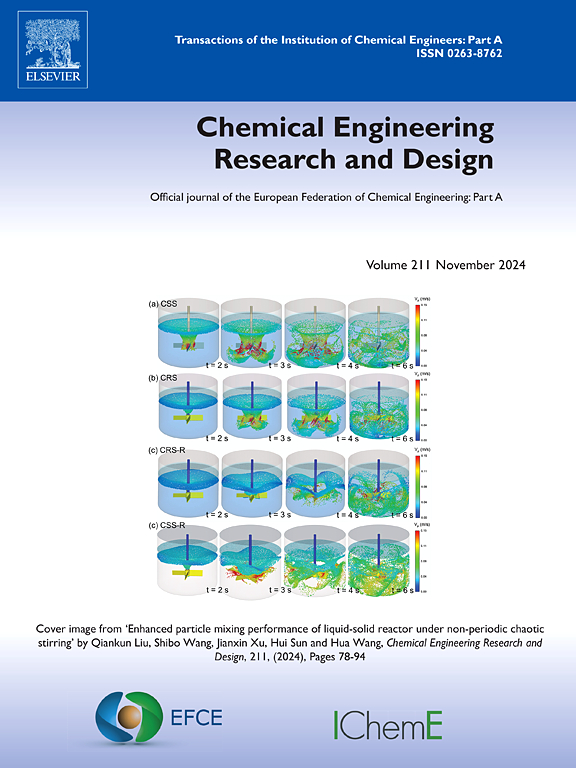Facile synthesis of novel graphene-based magnetized nanocomposite for the simultaneous elimination of lead (II) and chromium (VI) in aqueous medium: Insights of interfacial studies
IF 3.7
3区 工程技术
Q2 ENGINEERING, CHEMICAL
引用次数: 0
Abstract
Green and sustainable approaches have received greater attention in synthesizing advanced materials for efficient wastewater treatment processes. The mesoporous magnetized nanomaterials were synthesized employing bioderived graphene oxide and bentonite. The advanced tools characterized the nanocomposite materials extensively. Further, the synthesized composite was utilized to efficiently eliminate lead (II) and chromium (VI), both individually and simultaneously, from aqueous medium. The theoretical modeling using the Sips expanded equation proved the material's effectiveness in eliminating such ions. Parametric studies reveal solid-solution interface interactions influenced by pH, concentration, and electrolyte levels. 32.84 and 5.17 mg/g are the sorption capacities of the nanocomposite solid for lead (II) and chromium (VI), respectively. In contrast, pH being 3.7, a binary system of lead (II) to chromium (VI) with a 1:1 ratio showed 27.5 and 25.1 mg/g for lead (II) and chromium (VI), respectively. Several studies involving interfering co-ions and real matrix samples further demonstrate the efficacy of nanocomposite materials in eliminating these pollutants. The 0.1 mol/L of HCl and H2SO4 solutions efficiently recover the pre-sorbed lead (II) and chromium (VI) from the solid surface for four successive sorption/desorption processes, and successive use of the nanocomposite solid entails the potential of the nanocomposite solid in the sustainable unit operations.
在水介质中同时去除铅(II)和铬(VI)的新型石墨烯基磁化纳米复合材料的快速合成:界面研究的见解
绿色和可持续的方法在合成用于高效废水处理过程的先进材料方面受到了越来越多的关注。以生物衍生氧化石墨烯和膨润土为原料合成了介孔磁性纳米材料。先进的工具对纳米复合材料进行了广泛的表征。此外,合成的复合材料被用于有效地去除水介质中的铅(II)和铬(VI),无论是单独的还是同时的。利用Sips展开方程的理论模型证明了该材料在消除此类离子方面的有效性。参数研究揭示了受pH、浓度和电解质水平影响的固溶界面相互作用。纳米复合固体对铅(II)和铬(VI)的吸附量分别为32.84和5.17 mg/g。在pH为3.7时,铅(II)与铬(VI)以1:1的比例二元体系中,铅(II)和铬(VI)分别为27.5和25.1 mg/g。一些涉及干扰共离子和真实基质样品的研究进一步证明了纳米复合材料在消除这些污染物方面的功效。0.1 mol/L的HCl和H2SO4溶液能有效地回收固体表面预吸附的铅(II)和铬(VI),并进行4次连续的吸附/解吸过程,连续使用纳米复合固体具有可持续单元操作的潜力。
本文章由计算机程序翻译,如有差异,请以英文原文为准。
求助全文
约1分钟内获得全文
求助全文
来源期刊

Chemical Engineering Research & Design
工程技术-工程:化工
CiteScore
6.10
自引率
7.70%
发文量
623
审稿时长
42 days
期刊介绍:
ChERD aims to be the principal international journal for publication of high quality, original papers in chemical engineering.
Papers showing how research results can be used in chemical engineering design, and accounts of experimental or theoretical research work bringing new perspectives to established principles, highlighting unsolved problems or indicating directions for future research, are particularly welcome. Contributions that deal with new developments in plant or processes and that can be given quantitative expression are encouraged. The journal is especially interested in papers that extend the boundaries of traditional chemical engineering.
 求助内容:
求助内容: 应助结果提醒方式:
应助结果提醒方式:


